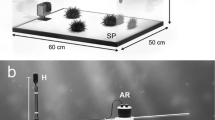Abstract
Micro-zooplankton abundance in Long Island Sound varied from 103 to 104 animals l-1 at the station studied and consisted almost entirely of tintinnids. The micro-zooplankton were found to sometimes remove a significant portion of the chlorophyll a standing stock, with an upper limit of 41% of the standing stock being ingested per day. Observed ingestion rates ranged from 0.001 to 0.17 ng chlorophyll a removed animal-1 h-1 and from 0.06 to 87 cells removed animal-1 h-1, depending on season and type of cell being ingested. Filtering rates varied from 1.03 to 84.7 μl animal-1 h-1. As a community, the micro-zooplankton exhibited the same order of magnitude ingestion and filtering rates as those noted for copepods.
Similar content being viewed by others
Literature Cited
Adams, J. A. and J. H. Steele: Shipboard experiments on the feeding of Calanus finmarchicus. In: Some contemporary studies in marine science, pp 19–36. Ed. by H. Barnes. London: G. Allen & Unwin 1966
Antia, N. J., C. D. McAllister, T. R. Parsons, K. Stephens and J. D. H. Strickland: Further mesurements of primary production using a large-volume plastic sphere. Limnol. Oceanogr. 8, 166–183 (1963)
Barnes, R. S. K.: Invertebrate zoology, 743 pp. Philadelphia: W. B. Saunders & Co 1968
Beers, J. R. and G. L. Stewart: Micro-zooplankters in the plankton communities of the upper waters of the eastern tropical Pacific. Deep-Sea Res. 18, 861–883 (1971)
Deevey, G. B.: Oceanography of Long Island Sound, 1952–1954, V. Zooplankton. Bull. Bingham. oceanogr. Coll. 15, 113–155 (1956)
Dussart, B. M.: Les différentes catégories de planction. Hydrobiologia 26, 72–74 (1965)
Frost, B. W.: Effects of size and concentration of food particles on the food behavior of the marine planktonic copepod Calanus pacificus. Limnol. Oceanogr. 17, 805–815 (1972)
Gauld, D. T.: The swimming and feeding of planktonic copepods. In: Some contemporary studies in marine science, pp 313–334. Ed. by H. Barnes. London: G. Allen & Unwin 1966
Heinbokel, J.F.: Studies on the functional role of tintinnids in the Southern California Bight. 1. Grazing and growth rates in laboratory cultures. Mar. Biol. 47, 177–189 (1978a)
Heinbokel, J. F.: Studies on the functional role of tintinnids in the Southern California Bight. II. Grazing rates of field populations. Mar. Biol. 47, 191–197 (1978b)
Johansen, P. L.: Nitrogen excretion by tintinnids. A. Mtg Am. Soc. Limnol. Oceanogr. 1976 (Abstr.)
Jørgensen, C. B.: Biology of suspension feeding, 375 pp New York: Pergamon Press 1966
Loftus, M. E., D. V. Subba Rao and H. H. Seliger. Growth and dissipation of phytoplankton in Chesapeake Bay. I. Response to a large pulse of rainfall. Chesapeake Sci. 13, 282–299 (1972)
Lohmann, H.: Untersuchungen zur Feststellung des vollständigen Gehaltes des Meeres an Plankton. Wiss. Meeresunters. (Abt. Keil) 10, 131–370 (1908)
McLaren, I. A.: Effects of temperature on growth of zooplankton and the adaptive value of vertical migration. J. Fish Res. Bd Can. 20, 685–727 (1963)
McLaren, I. A.: Some relationships between temperature and egg size, body size, development rate and fecundity of the copepod Pseudocalanus. Limnol. Oceanogr. 10, 528–538 (1965)
Mullin, M. M.: Some factors affecting the feeding of marine copepods of the genus Calanus. Limnol. Oceanogr. 8, 239–250 (1963)
O'Connors, H. B., Jr., D. C. Biggs and D. V. Ninivaggi: Particlesize-dependent maximum grazing rates for Temora longicornis fed natural particulate assemblages. Mar. Biol. 56, 65–70 (1980)
Rassoulzadegan, F.: Dimensions et taux d'ingestion des particules consommées par un tintinnide Favella ehrenbergii (Clap. et Lachm.) Jörg., cilié pelagique Marin. Annls Inst. océanogr., Paris (N.S.) 54, 17–24 (1978)
Riley, G. A.: Oceanography of Long Island Sound, 1952–1954. IX. Production and utilization of organic matter. Bull. Bingham. oceanogr. Coll. 15, 324–341 (1956)
Sokal, R. R. and F. J. Rohlf: Biometry. The principle and practice of statistics in biological research, 776 pp. San Francisco: W. H. Freeman & Company 1969
Steemann Nielsen, E.: The relationship between phytoplankton and zooplankton in the sea. Rapp. P.-v. Réun. Cons. perm. int. Explor. Mer 153, 178–182 (1962)
Voronina, N. M. and I. N. Sukhanova: Food composition in the mass species of antarctic hervivorous copepods. Okeanologija, Mosk 16, 1082–1086 (1976)
Author information
Authors and Affiliations
Additional information
Communicated by I. Morris, West Boothbay Harbor
Contribution No. 259 of the Marine Sciences Center
Rights and permissions
About this article
Cite this article
Capriulo, G.M., Carpenter, E.J. Grazing by 35 to 202 μm micro-zooplankton in Long Island Sound. Mar. Biol. 56, 319–326 (1980). https://doi.org/10.1007/BF00386870
Accepted:
Issue Date:
DOI: https://doi.org/10.1007/BF00386870




